"Let the man have been tarred with the University stick and he will tell you along with his after-dinner cigar that he has a notion of some day building a house at Chapel Hill – and there remaining to the end of the chapter in the one place where he believes he can obtain a large and perfect peace. There men cling to the town and its surroundings with a memory that is both tenacious and jealous of details.
"A friend was describing to one of these - a graduate before the [Civil] war – the site of the present Alumni Building. Suddenly the old graduate’s eyes flashed fire: “What!” he exclaimed. “You don’t tell me they’ve cut down the old college linden! I’d rather they’d have gone without that building forever than that they should have touched that tree!”
"And so it goes. Living in the hearts of its scattered children, each tree shrub and rose bush, almost each stone of its serried ranks of rough built walls, bears its own faint story; and it is the indefinable suggestion that seems in time to float out from the inanimate things that have brushed on human hopes that strangely strikes the newcomer at the moment he places foot upon the campus and brings to the returned a tingling of the blood and a half forgotten smell of the air that at once exhilarate and recall to half sad dreams of bygone days."
Gray’s argument is essentially that the landscape of Chapel Hill is a part of the experience of being young and full of life in Chapel Hill. Revisiting the landscape of your young adulthood brings back fond memories of days gone by. Or in other words, there’s nothing like walking down Franklin Street to make you feel young again, or at least bring back wonderful and powerful memories. And any change at UNC (or in Chapel Hill) detracts from that feeling. Gray is saying that the things that are new interfere with the evocation of that brief feeling of youthfulness, and you consequently dislike them.
Gray’s theory is meant to explain the experience of returning alumni, who for example are sometimes crestfallen to find that the Rathskeller is no more, or similarly are shocked to see Greenbridge rising on Chapel Hill’s western border. I am not sure that the experience is exactly the same for those who live in and near Chapel Hill and return to UNC and downtown on a regular basis, but it is at least part of that story.
Gray makes no remark on Carrboro in part because the village scarcely existed in 1904, but Carrboro is not immune to this same issue. Probably the greatest challenge facing our town is how to expand our commercial tax base without compromising the sense of place that is Carrboro. And I suppose such things are challenges for any community, but I think Gray is suggesting that this phenomenon is especially strong in Chapel Hill because so many people discover the town as 18-year-olds, entering the prime of life and for the first time living with new found freedom. This is true for Carrboro as well, although somewhat less so because Carrboro is less a part of the undergraduate experience for most students.
It is also interesting to note that Gray mentions that a part of this phenomenon is that the critic of change “has a notion of some day building a house at Chapel Hill.” Gray does not remark upon the irony of the critic at once lamenting any change to the Chapel Hill landscape and expressing his desire to change that same landscape by building his own house there. No doubt the critic feels that although change in Chapel Hill is bad, just one more house won’t hurt, as long as it is his.
From today’s vantage point, it also seems ironic that the critic would lament the construction of Alumni Hall:
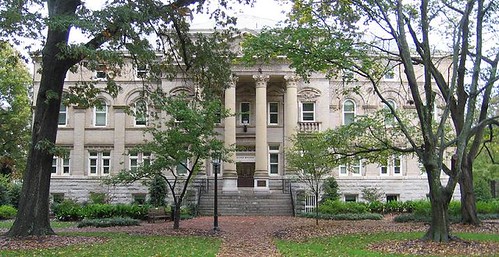
Alumni Hall is in fact one of the buildings that gives secondary definition to McCorkle Place and has many beautiful architectural details. That anti-Alumni Hall sentiment seems particularly ironic in light of Davie Hall, which UNC went on to build only 200 yards away:
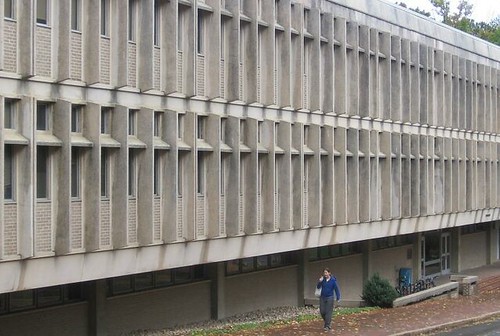
The desire to return to a Chapel Hill that was known from earlier days goes still further back in UNC's history. William D. Moseley, a member of the UNC class of 1818, wrote a letter to his former professor Elisha Mitchell in 1853: “I know of no earthly pleasure which would afford me more heartfelt satisfaction than a short stay at that village [Chapel Hill]; where I could again refresh my memory with a review of the places and things that still remain as mementos of days that are past; when the future was looked to with hopes, never to be realized.”
At some level, none of this is lost on either the administration of the University or the government of the Town, for both have sometimes made wise choices about the preservation of the historical landscape. Among Moseley’s other comments in his 1853 letter: “I would like too to visit the Old Poplar, in the right of the path leading from the Chapel to Dr Caldwell's. Is it still living?” Not only was it still living in 1853, but it is still living today:
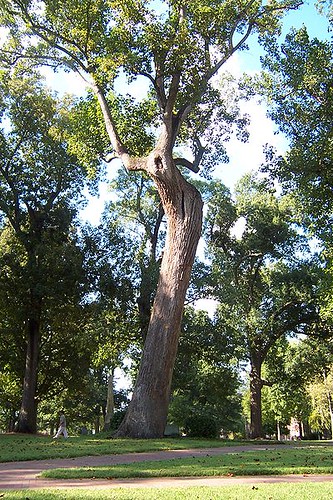
Moseley’s letter implies that the Davie Poplar was a noted landmark even when the University was young. And clearly it was called “the Old Poplar” even by members of the class of 1818. It was already at least 100 years old when Moseley graduated. The Davie Poplar is now at least 300 years old and some think it may be approaching 400.
But nothing in this world lasts forever, and UNC began preparing for the inevitable about 90 years ago by grafting a cutting of the Davie Poplar to create Davie Poplar, Jr., which grows in the shadows of the original. And more recently a seedling of the Davie Poplar was cultivated and planted nearby with the appellation Davie Poplar, III. It's right in front of Alumni Hall as it happens. While obviously no one is hoping for the day when the Davie Poplar falls, it is reassuring to know that UNC has long since begun to prepare for that day.
Likewise, no one hopes for the day when our community will face dramatic changes brought about by greenhouse gasses as well as the ever-increasing cost (and ever-decreasing supply) of petroleum. But we cannot bury our heads in the sand and hope that such challenges will never come. They will come and we all know it. At the local level, Carrboro, UNC and Chapel Hill can make only the most incremental changes to the composition of the atmosphere or the supply of available petroleum. But we can and we must prepare for the future that we know is coming.
Preparing for a world with fewer cars and less petroleum will partly involve technological breakthroughs in sustainable energy, but it must also involve dramatic improvements in energy efficiency. And one way for us to reduce our society’s demand for energy - a way that is entirely within the control of local government in North Carolina - is to change our built landscape – to create a more pedestrian, bicycle and transit friendly landscape. And that will involve a more compact form of development, focused on key transportation corridors.
One area that is appropriate for the new landscape that our community will need is the NC 54 corridor between Meadowmont and UNC, along the planned route of the Triangle’s light-rail system. Downtown Carrboro and downtown Chapel Hill are also areas where outstanding public transportation is already readily available and are appropriate places for more intense development. Yet, the importance of the landscape, the sense of place in these locations cannot be ignored.
How would Carrboro be Carrboro without these buildings:
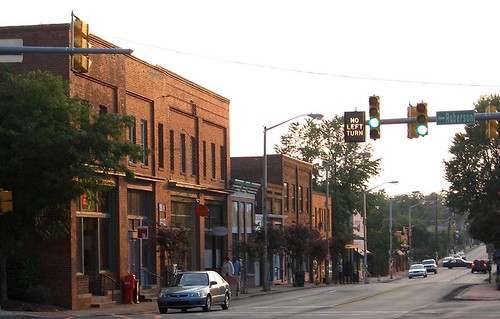
On the other hand, some downtown Carrboro buildings seem considerably less essential:
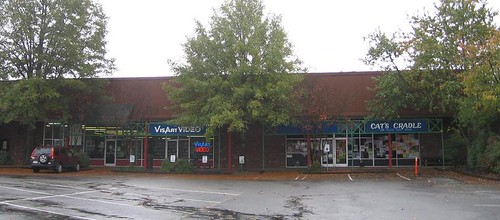
To be clear these businesses are essential, but the buildings are not.
Likewise, the Best Western University Inn
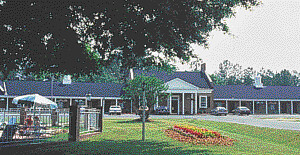
was a pretty unremarkable building. The grassy areas out front were pleasant, but it was mostly a low utilitarian building with a sea of asphalt in front. The picture above was taken as a publicity photo and it still makes the building and lot look unremarkable (at best). East54's critics only ever acknowledge this reality when prompted to do so. Likewise there seems to be no public acknowledgement that the site of Greenbridge was not long ago a flophouse for crack dealers. Does any of this mean that East54, Greenbridge or 300 E. Main Street will be perfect? Of course not. But let’s be clear, what they are replacing was not so terrific as some would like to pretend.
Change is inevitable for Carrboro and Chapel Hill. The challenge is to keep the elements that are central to our landscape from the past, while creating a more energy-efficient and pedestrian friendly landscape for the future. Personally, I think that is something that Carrboro, UNC and Chapel Hill can do.
Nice writing, Mark. was nice riding around town with you today.
ReplyDeleteThanks, Chris. I appreciate the help with the photos!
ReplyDeleteNice post. Appreciate the illustrations and thoughtful approach to the preservation/change discussion.
ReplyDelete